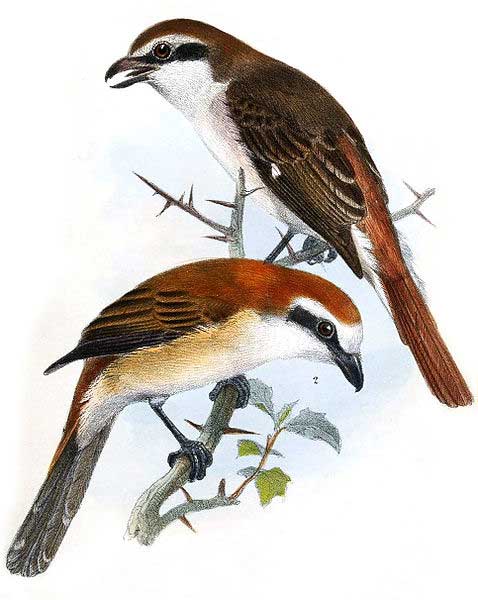
Lanius isabellinus
Superregnum: Eukaryota
Regnum: Animalia
Subregnum: Eumetazoa
Cladus: Bilateria
Cladus: Nephrozoa
Superphylum: Deuterostomia
Phylum: Chordata
Cladus: Craniata
Subphylum: Vertebrata
Infraphylum: Gnathostomata
Superclassis: Tetrapoda
Cladus: Reptiliomorpha
Cladus: Amniota
Classis: Reptilia
Cladus: Eureptilia
Cladus: Romeriida
Subclassis: Diapsida
Cladus: Sauria
Infraclassis: Archosauromorpha
Cladus: Crurotarsi
Divisio: Archosauria
Subsectio: Ornithodira
Subtaxon: Dinosauromorpha
Cladus: Dinosauria
Ordo: Saurischia
Cladus: Theropoda
Cladus: Neotheropoda
Infraclassis: Aves
Ordo: Passeriformes
Subordo: Passeri
Parvordo: Corvida
Superfamilia: Corvoidea
Familia: Laniidae
Genus: Lanius
Species: Lanius isabellinus
Subspecies: L. i. arenarius – L. i. isabellinus – L. i. tsaidamensis
Name
Lanius isabellinus Hemprich & Ehrenberg, 1833
References
Symbolae Physicae (1828) sig.e: un-numbered page.
Vernacular names
العربية: صرد محمر الذنب
brezhoneg: Pig-spern Kreizazia
Deutsch: Isabellwürger
English: Isabelline Shrike
Esperanto: Izabela lanio
eesti: Kõnnuõgija
فارسی: سنگچشم دم سرخ
suomi: Punapyrstölepinkäinen
føroyskt: Morbøkutur eystantyrningur
français: Pie-grièche isabelle
magyar: Pusztai gébics
հայերեն: Շամփրուկ շիկապոչ
日本語: アカオモズ
latviešu: Sarkanastes čakste
монгол: Тольт дунхай
norsk: Rødhalevarsler
polski: Dzierzba pustynna
русский: Рыжехвостый жулан
svenska: Isabellatörnskata
Türkçe: Kızıl kuyruklu örümcek kuşu
中文: 荒漠伯劳
The isabelline shrike or Daurian shrike (Lanius isabellinus) is a member of the shrike family (Laniidae). It was previously considered conspecific with the red-backed shrike and red-tailed shrike. It is found in an extensive area between the Caspian Sea and north and central China southeast to the Qaidam Basin. Overwinters in Africa and Arabia.
Etymology
The genus name, Lanius, is derived from the Latin word for "butcher", and some shrikes are also known as "butcher birds" because of their feeding habits. The common name is from the specific isabellinus, New Latin for "greyish-yellow" probably named for Isabella I of Castile, said to have promised not to change her undergarments until Spain was freed from the Moors.[2] The common English name "shrike" is from Old English scríc, "shriek", referring to the shrill call.[3]
wintering in Great Rann of Kutch
Lanius isabellinus - MHNT
Habits
This migratory medium-sized passerine eats large insects, small birds, rodents and lizards. Like other shrikes it hunts from prominent perches, and impales corpses on thorns or barbed wire as a larder. It breeds in open cultivated country, preferably with thorn bushes.
Description
The plumage is isabelline, the sandy colour which gives rise to its name. It has a red tail. Young birds can be distinguished from young red-backed shrikes by the much sparser vermiculations on the underparts.
References
BirdLife International (2016). "Lanius isabellinus". IUCN Red List of Threatened Species. 2016: e.T103718693A93995010. doi:10.2305/IUCN.UK.2016-3.RLTS.T103718693A93995010.en. Retrieved 12 November 2021.
Jobling, James A (2010). The Helm Dictionary of Scientific Bird Names. London: Christopher Helm. pp. 207, 219. ISBN 978-1-4081-2501-4.
"Shrike". Oxford English Dictionary (Online ed.). Oxford University Press. (Subscription or participating institution membership required.)
Further reading
Identification
Worfolk, Tim (2000) Identification of red-backed, isabelline and brown shrikes Dutch Birding 22 (6): 323-362
Retrieved from "http://en.wikipedia.org/"
All text is available under the terms of the GNU Free Documentation License

